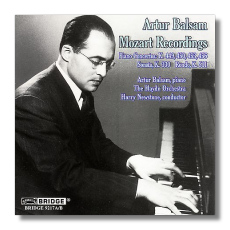
The Internet's Premier Classical Music Source
Related Links
- Mozart Reviews
- Latest Reviews
- More Reviews
-
By Composer
-
Collections
DVD & Blu-ray
Books
Concert Reviews
Articles/Interviews
Software
Audio
Search Amazon
Recommended Links
Site News
 CD Review
CD Review
Wolfgang Mozart

Middle Piano Concertos
- Concerto for Piano #14 in E Flat Major, K 449
- Concerto for Piano #15 in B Flat Major, K 450
- Concerto for Piano #17 in G Major, K 453
- Concerto for Piano #18 in B Flat Major, K 456
- Rondo in A Major, K. 311
- Sonata for Piano in C Major, K. 330
Artur Balsam, piano
The Haydn Orchestra/Harry Newstone
Bridge BCD9217A/D 2CDs: 67:00, 66:30 ADD monaural
Bridge continues its survey of performances by Polish-born pianist Artur Balsam (1906-1994) with this release devoted entirely to music by Mozart. Although Balsam's career often found him playing the piano behind or next to more famous musicians such as Yehudi Menuhin or Nathan Milstein, or making chamber music in the company of equals, he was a pianist who could stand the attention of the spotlight. Balsam also made his mark as a teacher, and in bringing less familiar music (particular from the Classical era) to the attention of the public.
These discs remind us that there was a time when general knowledge of Mozart's piano concertos was limited to Concerto #20 and beyond. Balsam not only played most (if not all) of Mozart's concertos, he prepared performing editions of several of the earliest ones. In other words, he knew this music intimately; he wasn't just performing it to check off boxes, as it were. Bridge's earlier Balsam release (Bridge 9196 A/B) contains some of his Concert Hall recordings of even earlier concertos by Mozart (Nos. 8 and 13), Beethoven (the piano version of his Violin Concerto), Hummel, and C.P.E. Bach, so it should be obvious that Balsam's attention to the byways of the Classical repertoire was not just a fluke.
The concertos on this pair of discs come not from studio recordings, but from BBC broadcasts in June 1956. (The Sonata is taken from a Concert Hall LP that sounds about as old, although Bridge's audio engineer Adam Abeshouse has done a good job putting makeup over its blemishes. The Rondo comes from a live performance at the Manhattan School of Music from as late as 1980.) Conductor Harry Newstone was born in Canada in 1921. In his first career, he established himself as a harmonica virtuoso, but later on, he studied conducting. In the late 1940s, he founded the Haydn Orchestra. Predating most of the period-style performance movement, the Haydn Orchestra specialized in playing Classical music in a more authentic manner than was the norm at the time, even if "authentic instruments" generally were not available or practical just yet.
These performances are examples of how the middle of the road need not be boring. As we are told in the booklet notes (written by Bridge's own David Starobin), Balsam did not believe that Mozart's Allegros should be played too fast, nor his Andantes too slow. Similarly, those looking for explosive accents and extreme emotions will not find them here. This is Mozart at his most housebroken. If some of the drama is missing, then there is no lack of beauty and, when you least expect them, moments of gentle pathos. Balsam's fingers bring absolute clarity to even the most hazardous passages, and his mastery of touch and weight means that the left and right hands are perfectly balanced, and chords are perfectly voiced. One doesn't always feel that Balsam and Newstone are engaged in a true dialogue. Nevertheless, the balance between the piano and the orchestra is just fine. No doubt Newstone's reduced forces facilitated that task. Overall, because Balsam and Newstone give us interpretively, emotionally scaled-down Mozart, we have to give more of ourselves to the music when we hear it. There is nothing wrong with that.
The only time one is aware of an audience is when there is applause, at the end of the Rondo. The sound throughout is a little dull, but very warm and free of distortion. I don't think it will scare anyone away.
Copyright © 2007, Raymond Tuttle




















